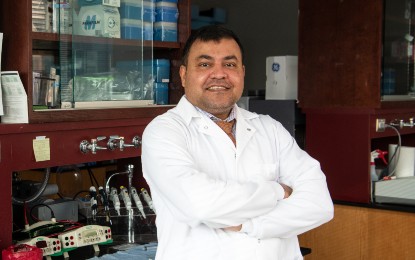Som Chatterjee, PhD, UMSOD assistant professor, is among researchers describing a significant advancement in the battle against drug-resistant bacteria.
Staphylococcus aureus — or S. aureus — bacteria commonly found in both community and hospital settings, causes many serious infections, such as pneumonia, or bloodstream or bone and joint infections. Infections caused by S. aureus are challenging to treat because of the emergence of multi-drug resistant strains, such as methicillin-resistant Staphylococcus aureus, or MRSA.

Som Chatterjee, PhD, UMSOD assistant professor, is among researchers describing a significant advancement in the battle against drug-resistant bacteria.
According to the U.S. Centers for Disease Control and Prevention, an estimated 119,247 cases of S. aureus bloodstream infections and 19,832 associated deaths occurred nationwide in the U.S. in 2017.
However, a recent study published in the journal Nature, titled “Structural basis of broad-spectrum β -lactam resistance in Staphylococcus aureus,” has described what promises to be a major advancement for overcoming MRSA’s drug resistance. A team of researchers, including Som Chatterjee, PhD, an assistant professor in the Department of Microbial Pathogenesis at the University of Maryland School of Dentistry, and two members of his lab, Nidhi Satishkumar, doctoral student and graduate research assistant; and Raymond Poon, lab technician, have discovered the mechanism by which S. aureus develops a resistance to the beta-lactam class of antibiotics, which are commonly prescribed drugs for fighting bacterial infections.
“Despite progress in the development of new therapeutics, S. aureus is known for causing a high number of deaths that can be attributed to antimicrobial resistance. It is a global problem,” said Chatterjee, who holds a joint appointment at the Institute of Marine and Environmental Technology in Baltimore. “Improved treatment options are critically needed and our clearer understanding of this pathogen’s ability to resist the actions of the beta-lactam class of antibiotics can help us preserve the action of these important antibiotics.”
Chatterjee described two ways in which pathogens can become antibiotic resistant. First, “natural selection” can be at play when a bacterial colony survives an antibiotic exposure due to acquired mutation, propagates, and, over time, evolves to become resistant to the antibiotic.
The second path to antibiotic resistance can occur through gene transfer — a process by which a bacterium picks up an antibiotic resistance gene and then, when subsequently exposed to that antibiotic, becomes resistant. A similar gene transfer event has been attributed to the development of methicillin-resistant S. aureus.
For Chatterjee, the team’s most significant find was determining the role of a receptor in the MRSA bacteria, called “BlaR1,” which senses beta-lactam drug in its bacterial surrounding and interacts with “Blal,” a beta-lactam repressor to mediate resistance.
According to the researchers, the structure of BlaR1 had been unclear since its function was identified over 20 years ago. However, their recent work has revealed the structure and molecular details of BlaR1’s action at the atomic level.
“Now that we better understand BlaR1 structure and function as well as its interplay with Blal, we can potentially inhibit their interplay through designing new drugs that target BlaR1 function and, thus, preserving the beta-lactam drug class action,” Chatterjee said.



